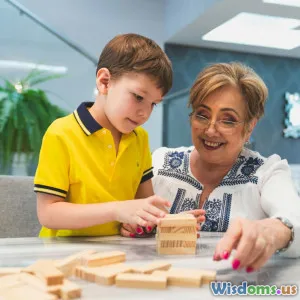
How Birth Order Influences Sibling Roles at Home
33 min read Explore how birth order shapes sibling roles, responsibilities, and behavior at home, with practical tips for balanced dynamics. (0 Reviews)
Every family has its quiet gravitational forces—unseen pulls that shape who sets the table, who negotiates the bedtime, and who becomes the family’s resident peacemaker or class clown. Birth order is one of those forces. It isn’t destiny, and it isn’t a stereotype that fits neatly on every household; rather, it’s a pattern of nudges and expectations that accumulate into recognizable roles. Understanding these patterns doesn’t just satisfy curiosity. It gives parents, caregivers, and siblings practical tools to reduce friction, share responsibilities fairly, and help each child define a healthy identity.
What Research Really Says About Birth Order

Birth order has been debated since the early 20th century. Alfred Adler first popularized the idea that firstborns, middles, and youngest children adopt distinct styles to find their place in the family. Later, Frank Sulloway’s Born to Rebel argued that firstborns lean toward authority and convention while later-borns become more rebellious and open to experience. Those claims captured the public imagination—but do they hold up?
Large-scale studies now give a more nuanced picture:
- Personality effects are small to negligible overall. Analyses using national datasets in the U.S. and Europe (for example, Damian & Roberts, 2015; Rohrer, Egloff & Schmukle, 2015) show minimal differences on the Big Five personality traits by birth order when researchers control for family size, socioeconomic status, and other factors. The notable exceptions are small, consistent differences where firstborns score very slightly higher on conscientiousness and sometimes self-reported leadership—differences that often do not show up in observer ratings.
- Intelligence differences are small but reliable on average. Several studies (e.g., Kristensen & Bjerkedal, 2007; Black, Devereux & Salvanes, 2005) report a modest firstborn advantage in measured IQ, typically around a single IQ point. That’s not enough to decide a life path, but it’s consistent across large samples, suggesting that family dynamics (and sometimes parental investment) can influence test performance.
- Context matters more than order alone. The size of gaps between siblings, the number of siblings, parental stress, cultural expectations, and whether the family is blended or multigenerational all shape how birth order plays out at home.
In short: birth order nudges, it doesn’t dictate. Think of it as a gentle current. It can set a default direction, but parenting practices, life events, and individual temperament can steer a child onto a very different course.
Mechanisms That Shape Sibling Roles

If birth order effects aren’t destiny, what mechanisms produce the recurring patterns families notice? Several well-established dynamics play a part:
- Resource dilution. As families grow, time, attention, and money are spread across more children. This doesn’t mean later-borns are “deprived,” but they may get fewer one-on-one reading sessions or less individualized coaching. The classic resource dilution hypothesis (Judith Blake) helps explain why firstborns sometimes benefit academically.
- The confluence model. Psychologists Robert Zajonc and Gregory Markus proposed that the intellectual environment of a household shifts as more children join. Older siblings interact with adults more in the early years, while later-borns experience a more mixed-age environment. The kicker: when older siblings teach younger ones, the teachers also gain practice and reinforcement, which can help older children consolidate skills.
- De-identification. Siblings often reduce rivalry by differentiating from each other. If one child claims the “academic” niche, another might pivot to sports or the arts. This de-identification process, suggested by scholars like David Schachter and later expanded in family systems research, reduces direct competition but can harden into stereotypes if parents aren’t careful.
- Parent expectations and path dependence. Firstborns may be tasked with small “managerial” roles—watching a younger sibling at the park, modeling homework habits—which can snowball into more responsibility and a self-concept built around reliability. Youngest children receive more autonomy in some tasks and more protection in others, nudging them into risk-friendly or charm-based strategies.
- Observational learning. Younger siblings get to watch rules being negotiated by older siblings. They learn how to appeal to parents, when to push back, and which chores are flexible. Older siblings, meanwhile, see themselves mirrored in younger ones and may internalize a caretaker identity.
- Asymmetric feedback loops. The oldest gets intense feedback early; the youngest gets concentrated attention late, often after parents have more experience. Middle children might receive more autonomy, but also less spotlight. Each position creates a different ratio of feedback, autonomy, and structure.
These mechanisms interact. For example, in a family under financial stress, resource dilution may be more pronounced, amplifying a firstborn academic edge. In a blended family, de-identification may revolve around step-sibling roles and new house rules. The point isn’t to shoehorn children into boxes, but to see the systems that nudge them—and to adjust those systems thoughtfully.
Common Sibling Archetypes—and How They Emerge

Archetypes are helpful shorthand, not certificates of identity. Use them as a lens to observe default patterns, then customize for your child.
- Firstborn: the deputy adult. Many firstborns are early rule-followers who step into leadership during chores or homework time. They might enforce bedtime norms, check task lists, or intervene when a younger sibling breaks a rule. Why it emerges: early exclusive time with adults, early exposure to responsibilities, and parent expectations that often follow “you’re older, you know better.” Example at home: Eight-year-old Maya reminds her five-year-old brother to pack his lunch; she enjoys the praise but resents being the “backup parent” when it cuts into her reading time.
- Middle child: the bridge builder. Middle children often learn to negotiate between older authority and younger spontaneity. This can foster empathy, diplomacy, and a keen sense of fairness. Why it emerges: frequent exposure to both “upward” and “downward” relational dynamics; a drive to stand out encourages them to cultivate social skill niches. Example at home: Ten-year-old Luis helps settle disputes by proposing compromises—15 minutes of the older sibling’s game, then 15 minutes of the younger’s.
- Youngest: the agile innovator. Many last-borns figure out how to bend rules or get time with busy parents by being funny, persuasive, or particularly persistent. Why it emerges: they watch negotiations, see boundaries as flexible, and find that humor or charm opens doors. Example at home: Six-year-old Rina gets extra bedtime stories by inviting Dad to “review” her drawings—a strategy she saw her older brother use for homework checks.
- Only child: the solo collaborator. Only children grow up partnering primarily with adults, which can build mature conversation skills, self-direction, and comfort with independent projects. Potential trade-off: fewer at-home chances to practice sibling-style conflict resolution. Example: Twelve-year-old Noor organizes her own study schedule but gets frustrated when peers don’t follow routines she thinks are obvious.
- Twins and close-in-age siblings: parallel captains. Twins often specialize to reduce friction: one might claim artistic leadership, the other logistics. Close-in-age siblings can run like a small team, challenging typical seniority because both remember being “the little one” not long ago. Example: Twins Ari and Sam divide chores—Ari handles dishes; Sam manages the family calendar board—reducing head-to-head competition.
- Widely spaced siblings: quasi-only plus mentor. With gaps of five or more years, oldest and youngest may experience different “versions” of the family. The older may act as a co-tutor; the younger may have a quieter childhood and more adult talk. Example: Seventeen-year-old Jonah teaches nine-year-old Tia basic coding on weekends; Tia is more comfortable with adults than with kids her own age.
Again, these are patterns, not pronouncements. Personality, health, school culture, and parenting style can flip any of these scripts.
When Birth Order Meets Chores, Rules, and Conflict

Roles feel most concrete in daily logistics: who does what, who decides what, and how disagreements end.
- Chores. Firstborns often default to “quality control”—they ensure tasks are completed, which saves parents time but can fuel resentment. Later-borns may be quicker to experiment with shortcuts. Actionable tweak: rotate leadership for specific chores. For example, Monday and Tuesday, the middle child checks that dishes are stacked correctly; Wednesday and Thursday, the youngest confirms floors are swept; Friday, the oldest performs a final five-minute walkthrough.
- Rules and privileges. Seniority-based privileges (curfew, phone time) can make sense, but if they are too rigid, younger siblings disengage or escalate. Actionable tweak: tie privileges to demonstrated responsibility, not age alone. For example, a checklist of: no missing homework for a week, morning routine done independently, and timely chore completion.
- Conflict patterns. Firstborns might appeal to rules; youngest might push to renegotiate; middle children may triangulate. Actionable tweak: use a two-step resolution process—(1) each sibling states the other’s position fairly; (2) they propose two options each, then pick one from the other person’s list. This reduces the advantage of the more assertive sibling.
A brief scenario: Two siblings want the tablet at 6 p.m. The firstborn cites “first come, first served.” The youngest makes a playful bid. Parent response: “We’re using the two-by-two choice. Lay out two options each.” Firstborn: “A) I use it 6:00–6:25, you 6:25–6:50; B) You choose the app, I choose the time.” Youngest: “A) I go first but only 15 minutes; B) We watch a show together for 20 minutes, then I draw while you use it.” They cross-choose, and a timer goes on. Repeated use turns conflict into a practice field for fair negotiation.
Culture, Economics, and Family Structure Matter

Birth order plays out differently across cultures and economic realities.
- Collectivist traditions. In multigenerational households, firstborns often take on caregiving and cultural transmission roles, endorsing family-first values. Younger siblings may specialize in collective success—helping a family business or managing tech for elders—rather than carving a separate identity.
- Economic strain. When time and money are tight, resource dilution can intensify. Older siblings may shoulder childcare or translation duties, as documented in research with immigrant families. Later-borns may become practical problem-solvers who navigate systems (school forms, appointments) with sibling guidance.
- Blended families. Birth order can reset. A child who was the youngest in one household may be “middle” in a stepfamily. Clear agreements about expectations in both homes help prevent confusion and rivalry.
- Single-parent households. Authority may be concentrated; older siblings often become logistical anchors. Parents can counterbalance by ensuring younger siblings get dedicated one-on-one time and by publicly recognizing the older child’s help without making it an identity burden.
- Rural vs. urban contexts. On farms or in family businesses, kids’ roles align with concrete tasks: feeding animals, stocking shelves. Urban families may assign roles around public transit navigation or scheduling. Either way, responsibility should match competency, not just age.
A guiding principle: align tasks with the child’s skills and bandwidth today, not the role you think their birth order dictates.
The Digital-Age Twist on Sibling Roles

Screens sharpen old patterns and create new ones.
- Tech gatekeepers. Firstborns often get devices earlier. They set informal norms for app choices and screen rules, becoming the family’s tech gatekeepers. Later-borns learn the loopholes.
- Platform specialization. Younger siblings may become content creators (short videos, art apps) while older ones manage logistics (calendar syncing, school portals). Leverage this by pairing roles: the youngest creates a bedtime playlist; the oldest sets up the family’s shared calendar.
- Teaching moments. Have older siblings teach a digital skill once per month (e.g., “Explain how to check permissions in an app”). Rotate the instructor so later-borns also teach something they’re good at—maybe photo editing or voice commands—preventing a hierarchy of expertise.
- Device-sharing rules. Use visible timers and neutral rules, not ad hoc negotiations. Try the 30-30 swap with a shared charging dock and a whiteboard that lists who has the next slot, reducing debates about “you promised me.”
- Safety protocols. Create a sibling pledge: no one posts a picture of another family member without consent; everyone knows how to screen-record for evidence if harassment occurs; and older siblings help younger ones report or block when necessary.
Actionable Strategies for Parents and Caregivers

Use these concrete, birth-order-aware steps:
- Rotate leadership. Assign weekly “captains” for recurring tasks (tidy-up captain, dinner-helper captain). The captain makes the plan; others execute. Rotate through all kids, regardless of age.
- Calibrate responsibility to bandwidth. At test time or during sports season, lighten the older child’s household load. Post a simple load meter on the fridge (Green = room for extra chores; Yellow = standard; Red = reduce to essentials).
- Praise by process, not role. Replace “You’re the responsible one” with “You made a list and checked it—great planning.” This prevents identity lock-in.
- Separate accountability from care. If the oldest supervises bedtime reading, they are not the enforcer. Keep enforcement with adults to avoid resentment.
- Rescue evenly. Avoid the trap of rescuing the youngest from consequences while holding the oldest to rigid standards. Apply the same safety net to all: a one-time “redo” coupon for missed chores per week.
- Schedule one-on-one time. Ten minutes daily per child, device-free, with the parent’s full attention. This counters resource dilution and reduces role-compensating behavior.
- Encourage role swaps. Ask the youngest to lead a warm-up stretch before dinner; ask the oldest to ask for help rather than offer it—just to practice.
- Use visual systems. Chore wheels, responsibility cards, and timers reduce appeals to authority (“Mom said!”) and focus on the system.
- Normalize learning curves. Tell family stories of times the youngest taught a skill or the oldest tried something messy and new. This models flexibility.
- Hold monthly “fairness audits.” Ask, “What feels fair? What doesn’t?” Rebalance chores, privileges, and praise.
Scripts and Micro-Habits That Work

Micro-habits make roles flexible and conflict manageable.
- The three-part acknowledgment. Parent to firstborn: “I see you reminding your brother about homework (observation). That keeps the evening on track (impact). Let’s make sure I’m the one doing the reminding tonight (boundary).”
- The table-turn question. Parent to youngest: “If you were in charge of the plan for 20 minutes, how would you make it fair for your sister?” Give real authority for 20 minutes to practice empathy and leadership.
- The redirection. To a middle child stuck as mediator: “You don’t have to fix this. Say, ‘I’m not the judge. I’ll listen for 2 minutes, then we go to Mom.’”
- The pause and propose. Sibling conflict rule: pause 60 seconds, write two solutions each, then pick one from the other person’s column.
- Five-minute rescue. Parents set a timer for five minutes to help any child who asks for it—no questions asked. Prevents a dynamic where the oldest is the only helper.
- The “ask before help” habit. Oldest says, “Do you want a tip or just time?” Younger sibling can opt for autonomy, reducing micromanagement.
How to Encourage Healthy Differentiation (Without Stereotyping)

Differentiation is good; rigid labels are not. Encourage variety without boxing children in.
- Rotate the spotlight. Alternate whose projects get display space on the fridge or a shelf. Use equal physical space to reinforce equal value.
- Diversify activities. If one child excels at soccer, invite the other to try coding club, the school play, or a robotics team. Praise risk-taking, not outcomes.
- Create fresh starts. New school year? New responsibilities and privileges list. New family job titles: “Curiosity Officer,” “Kindness Auditor,” “Budget Tracker,” rotating monthly.
- Praise contradictions. “You’re careful with details and willing to try weird ideas. That combo is powerful.” This prevents single-story identities.
- Set stereotype alarms. Whenever you catch yourself saying, “You’re always the X,” replace it with, “Lately I’ve noticed X. How does that feel? What do you want to practice next?”
Measuring Progress: A Simple Home Audit

Every two weeks, run a 15-minute audit together.
- Task balance. Are responsibilities matched to current bandwidth and skill? Any child carrying a chronic overload?
- Voice balance. Did each child make at least one family decision this week? If not, assign a quick decision to the quietest voice.
- Support balance. Did each child receive a five-minute rescue when they asked? If not, schedule a makeup.
- Celebration balance. Did praise land on effort across children? Note where praise felt tied to role stereotypes.
- Conflict pattern. Who tends to fold? Who tends to dominate? Try one adjustment: flip who speaks first or who sets the timer.
Use a visible checklist on the fridge and assign a rotating “audit leader.”
Quick Myths vs. Facts

- Myth: Birth order decides personality. Fact: Effects are small. Family culture, parenting, and temperament matter more.
- Myth: Firstborns are always leaders. Fact: They often get leadership practice, but many later-borns lead when the context fits their strengths.
- Myth: Youngest children are irresponsible. Fact: They can be highly resourceful and independent; they simply practice different strategies earlier.
- Myth: Middle children are neglected. Fact: They may receive less spotlight at times, but they often develop strong peer relationships and negotiation skills.
- Myth: Only children struggle socially. Fact: Only children often have strong adult-communication skills; peer skills grow with clubs, teams, and playdates.
Brief Case Studies You Can Relate To

Case 1: The overburdened firstborn
- Situation: Fourteen-year-old Kayla supervises two younger siblings daily while her mom works evenings. Grades dip.
- Intervention: Mom moves from implicit to explicit: “Kayla is not in charge of enforcement.” A neighbor teen is hired for two afternoons; the family institutes a five-minute rescue rule. Kayla’s chores shift to weekend meal prep, something she enjoys.
- Result: Within two months, Kayla’s grades rebound; her siblings still respect her but stop treating her as the default judge.
Case 2: The middle child turned diplomat
- Situation: Nine-year-old Omar mediates every dispute, becoming anxious.
- Intervention: Parents teach Omar a boundary statement and assign a fairness timer so disputes go to adults after two minutes. They praise Omar’s empathy without praising endless mediation.
- Result: Omar’s anxiety declines; siblings begin using the pause-and-propose tool.
Case 3: The inventive youngest
- Situation: Seven-year-old Pia habitually “forgets” chores and improvises. Older sibling complains.
- Intervention: Parents split chores into “choose your method” vs. “follow the list” tasks; Pia gets to design her own path for two of four jobs. Older sibling gets to pick music during chore time.
- Result: Pia’s completion rate jumps; older sibling feels respected as co-worker rather than supervisor.
Case 4: Widely spaced duo
- Situation: Sixteen-year-old Dev tires of teaching his eight-year-old sister, Mira, and feels he’s losing his own free time.
- Intervention: Family sets a weekly “skill swap” session capped at 25 minutes, with Dev teaching one skill and Mira teaching a fun micro-skill (e.g., a drawing trick). Dev gets a protective time block for his own pursuits.
- Result: Teaching becomes contained and more enjoyable; resentment drops.
If You’re a Sibling Reading This

You don’t have to accept a fixed family role.
- Ask for clarity. If you’re the oldest, try: “I can help for 10 minutes, but can you be the enforcer?” If you’re younger: “I want to do it myself; I’ll ask if I need help.”
- Negotiate swaps. Offer a trade—“I’ll fold laundry if you help me with math for 15 minutes”—to build reciprocity.
- Pick one growth edge. Oldest: practice asking for help once a day. Middle: practice saying no without justification once a week. Youngest: practice setting a timer and finishing a task before asking for rescue.
- Keep receipts, kindly. Track your contributions for a week; then share. “Here’s what I did. Can we make sure it’s balanced next week?”
- Build an alliance. You and your sibling can “team up” against confusion by agreeing to the two-by-two solution method and sticking to it.
Frequently Asked Questions

- What if siblings are five or more years apart? Treat them like different developmental zones. Assign leadership moments to the younger (e.g., pick the family walk route) and protect the older child’s time with clear off-duty hours.
- How do twins fit? Encourage complementary, rotating roles. One week, one twin is logistics lead; the next week, they flip. Avoid letting one become The Responsible Twin forever.
- Is an only child at a social disadvantage? Not inherently. Build peer practice through clubs, team projects, and regular playdates. At home, practice negotiation via board games and shared projects with cousins or friends.
- What about blended families? Reset expectations explicitly. Create a new chore chart and privileges list in the blended household, rather than importing old hierarchies. Hold a family meeting to co-create rules.
- How does neurodiversity change the picture? Align roles with individual needs and strengths. A child with ADHD might be stellar at high-energy tasks (e.g., active play with younger siblings) while needing scaffolds for routine chores. Keep fairness principle: equitable support is not identical support.
- Should older kids always babysit? No. If they do, compensate appropriately: a stipend, reduced other chores, or earned privileges. Babysitting is a job, not an identity.
Further Reading and Credible Sources

- Alfred Adler’s early work on family constellations (historical perspective on birth order ideas).
- Frank J. Sulloway, Born to Rebel (1996) — a popular account linking birth order to innovation; debated in later research.
- Brent W. Roberts & Rodica Damian (2015) — analyses suggesting minimal Big Five personality differences by birth order.
- Julia M. Rohrer, Boris Egloff, & Stefan C. Schmukle (2015) — German panel data finding negligible personality differences by birth order.
- Petter Kristensen & Tor Bjerkedal (2007) — Norwegian conscript data showing small IQ advantages for firstborns.
- Sandra E. Black, Paul J. Devereux, & Kjell G. Salvanes (2005) — economics research into family size, birth order, and child outcomes.
- Judith Blake (1981) — resource dilution hypothesis, examining how family size/spacing relate to educational outcomes.
- Robert S. Zajonc & Gregory B. Markus (1975) — confluence model on intellectual development in families.
- Susan M. McHale, Ann C. Crouter, & Corinna Jenkins Tucker (2016) — work on differential parenting and sibling dynamics.
- Judy Dunn & Robert Plomin (1990s) — research on siblings’ distinct experiences within the same family.
- Patricia L. East (2010) — studies on sibling caregiving in immigrant families.
Birth order is a quiet scriptwriter, but you’re the director. The most resilient families treat roles as starting points, not verdicts. They rotate leadership, praise process, and protect each child’s chance to try on new identities. With a few systems and a lot of empathy, siblings can turn everyday negotiations into a masterclass in cooperation—and make home feel less like a hierarchy and more like a team.
Rate the Post
User Reviews
Popular Posts



















